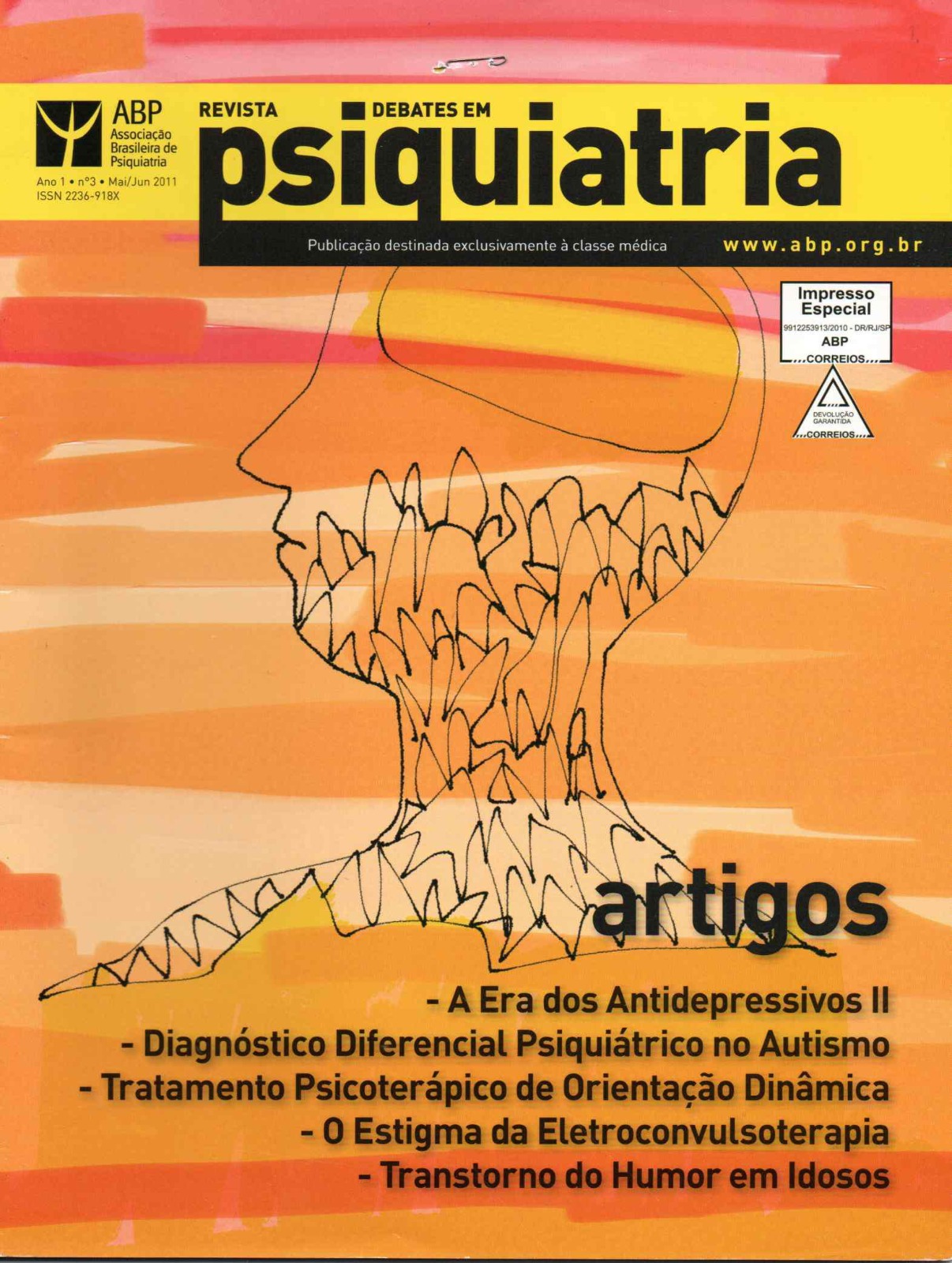Transtornos do humor em idosos
DOI:
https://doi.org/10.25118/2763-9037.2011.v1.869Palavras-chave:
depressão, idosos, diagnóstico, doenças clínicas, transtorno bipolarResumo
O Cérebro humano sofre alterações degenerativas durante o envelhecimento normal, com perda difusa de massa e neurônios, o que resulta em modificações na concentração e atividade dos neurotransmissores. Apesar destas alterações, a maioria dos idosos está satisfeita com sua vida, e não tem predisposição psicológica para desenvolver transtornos de humor. Entretanto, frente às vicissitudes do envelhecimento, alguns idosos podem apresentar um quadro de depressão maior, transtorno de humor bipolar, ciclotimia, distimia ou simplesmente apresentar “sintomas depressivos clinicamente significativos”, sendo importante a diferenciação entre quadros de início precoce e início tardio, além de se determinar a presença de causas ou complicadores orgânicos. Sabe-se que este adoecimento se deve a uma predisposição psíquica, mas também a uma associação dos sintomas com doenças clínicas, uso crônico de medicamentos e estressores psicossociais, situações mais frequentes nesta população quando comparados aos adultos jovens. As taxas de depressão em pacientes idosos, por exemplo, variam de 3,5% a 7,0% e representam um problema de saúde pública, tendo em vista seu impacto na saúde dos pacientes e a piora da qualidade de vida. O presente artigo tem o objetivo de descrever as características clínicas dos transtornos de humor em idosos, visando à promoção de um diagnóstico precoce, salientando as principais diferenças em relação aos adultos jovens, seja na qualidade ou intensidade dos sintomas, orientando os profissionais de saúde que atendem esta população de pacientes.
Downloads
Métricas
Referências
American Psychiatric Association. Diagnostic and Statistical Manual of Mental Disorders, 4th ed. Text revision. Washington, DC: American Psychiatric Association. 2000
Andrade L, Walters EE, Gentil V, Laurenti R. Prevalence of ICD-10 mental disorders in a catchment area in the city of São Paulo. Soc. Psychiatry Epidemiol, São Paulo, Jul. 2002, 37(7): 316-325.
Ballmaier M, Toga AW, Blanton RE, Sowell ER, Lavretsky H, Peterson J, Pham D, Kumar A (2004). Anterior cingulate, gyrus rectus, and orbitofrontal abnormalities in elderly depressed patients : an MRI-based parcellation of the prefrontal cortex. American Journal of Psychiatry 161, 99–108.
Barcelos-Ferreira R, Izbicki R, Steffens DC, Bottino CMC. 2010. Depressive morbidity and gender in community-dwelling Brazilian elderly: systematic review and meta-analysis. Int Psychogeriatr 22(5):712-26.
Beekman AT, Copeland JR, Prince MJ. Review of community prevalence of depression in later life. Br J Psychiatry. 1999;174:307-11.
Beusterin KM, Steinwald B, Ware JE-Jr. Usefulness of the SF-36 Health Survey in mesuring health outcomes in the depressed elderly. J Geriatr Psychiatry Neurol 1996; 9: 13-21.
Blay SL, Gastal F, Andreoli SB. Prevalência de distúrbios mentais em idosos vivendo na comunidade. Anais do XX Congresso Brasileiro de Psiquiatria. Florianópolis, 2002.
Blazer DG, Hughes DC, George LK. The epidemiology of depression in an elderly community population. Gerontologist. 1987; 27: 281-287.
Blazer DG, Williams CD. The epidemiology of dysphoria and depression in an elderly population. Am J Psychiatry. 1980; 137: 439-444.
Blazer DG. Psiquiatria Geriátrica. Em Tratado de Psiquiatria Clínica, 4 ed., Robert E. Hales e Stuart C. Ydofsky. Porto Alegre: Artmed, 2006.
Cole MG and Dendukuri N. Risk factors for Depression among elderly community subjects: a systematic review and meta-analysis American Journal of Psychiatry2003;160(6):1147–1156.
Costa E., Barreto SM, Uchoa E, et al: Prince M. Prevalence of International Classification of Diseases, 10th Revision Common Mental Disorders in the Elderly in a Brazilian Community: The Bambui Health. Ageing Study. Am J Geriatr Psychiatry 2007; 15:17–27.
Folstein MF, Folstein SE, Mchugh PR. 1975. ‘Mini Mental State’: a pratical method for grading the cognitive state of patients for the clinician. J Psychiatr Res 12: 189–198.
1Fundação do Instituto Brasileiro de Geografia e Estatística (IBGE). Tendências demográficas: uma análise dos resultados do Centro Demográfico 2000. Brasil; Rio de Janeiro, 2002.
Gallo JJ. Epidemiology of mental disorders in middle age and late life: conceptual issues. Epidemiol. 1995; 17(1):83-94.
Hales RE, Yudofsky SC. Psiquiatria Geriátrica, citado em Tratado de Psiquiatria Clínica, 4ª edição; cap 37. Porto Alegre: Artmed, 2006.
Lafer B et al. Depressão no Ciclo da vida. Porto Alegre: Artmed, 2001.
Lai T-J, Payne M, Byrum CE, Steffens DC, Krishnan KRR (2000). Reduction of orbital frontal cortex volume in geriatric depression. Biological Psychiatry 48, 971–975.
MacFall JR, Payne ME, Provenzale JM, Krishnan KRR (2001). Medial orbital frontal lesions in late-onset depression. Biological Psychiatry 49, 803–806.
Maremmani I, Pacini M, Perugi G, Deltito J, Akiskal H. Cocaine abuse and the bipolar spectrum in 1090 heroin addicts: clinical observations and a proposed pathophysiologic model. J Affect Disord. 2008 Feb;106(1-2):55-61.
Moreno, Ricardo Alberto et al. Anticonvulsivantes e antipsicóticos no tratamento do transtorno bipolar. Rev Bras Psiquiatr. Out 2004, vol.26, suppl.3, p.37-43.
Murray CJL, Lopez AD. The Global Burden of Disease. Publicado pela OMS e a “Harvard School of Public Health”, Harvard University Press, 1996.
Nardi AE. Como consideramos a depressão atualmente, em Questões atuais sobre depressão. 3ª edição revisada e ampliada. São Paulo. Lemos editorial, 2006
Novaretti T, Marcolin M, Júnior S. Hipersinais subcorticais no exame de ressonância magnética: comparação entre idosos deprimidos e idosos normais. Arq Neuropsiquiatr 2001; 59(3B):754-760.
Palsson S, Skoog I. The epidemiology of affective disarders in the elderly: a review. Int. Clin. Psychopharmacol. 1997; 12(suppl 7):s3-s13.
Stockmeier CA. Involvement of serotonin in depression: evidence from postmortem and imaging studies of serotonin receptors and the serotonin transporter. J Psychiatr Res. 2003 Sep-Oct;37(5):357-73
World Health Organization: Health topics 2008. Available at http://www.who.int/en/
Downloads
Publicado
Como Citar
Edição
Seção
Licença
Copyright (c) 2011 Ricardo Barcelos Ferreira, Cássio M. C. Bottino

Este trabalho está licenciado sob uma licença Creative Commons Attribution-NonCommercial 4.0 International License.
Debates em Psiquiatria permite que o (s) autor (es) mantenha(m) seus direitos autorais sem restrições. Atribuição-NãoComercial 4.0 Internacional (CC BY-NC 4.0) - Debates em Psiquiatria é regida pela licença CC-BY-NC
































